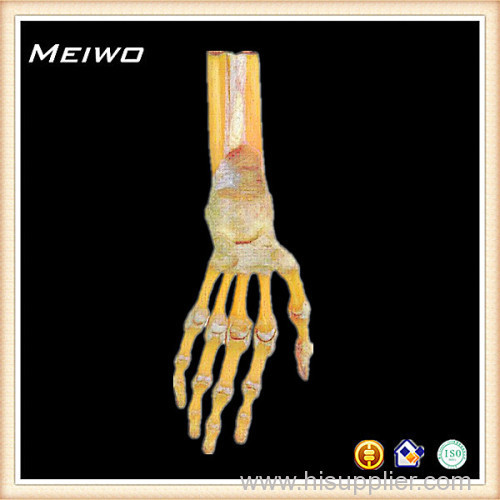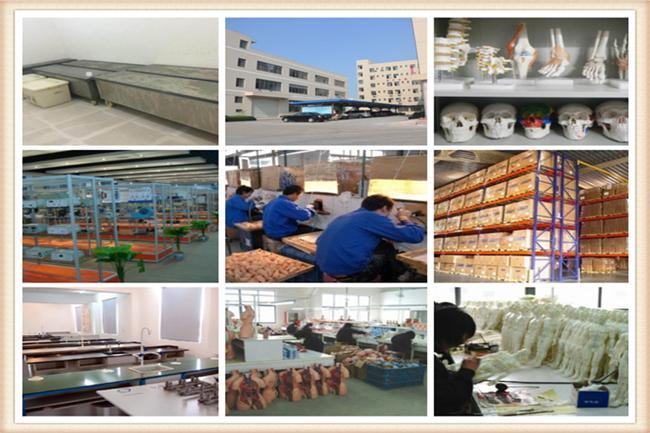

|
Meiwo Science Co.,Ltd
|
| Price: | 585.0 USD |
| Payment Terms: | T/T,L/C,WU |
| Place of Origin: | Henan, China (Mainland) |
|
|
|
| Add to My Favorites | |
| HiSupplier Escrow |
Product Description

specification:Hand joint plastinated specimens keeping all the capsules of the joints,showing wrist,intermetacarpal,metacarpophalangeal and interphalangeal joints.
| band | Meiwo |
| packing | packed in cartons |
| subject | plastinated specimens |
| maintenance method | coated with alcohol |
| specification | Hand joint plastinated specimens keeping all the capsules of the joints,showing wrist,intermetacarpal,metacarpophalangeal and interphalangeal joints |
Exhibition Centre
Meiwo has own exhibition center of science museum for customer visit.You can see various specimens ,models, manikins,etc .Hand joint plastinated specimens.


Packaging & Shipping
Our Package is neutral package by Plywood case and Flight case,inner side with white polyfoam.Of course, we are glad to do the package as per customer requirements.
Loading cuontainers normally;Also we could load containers with pallets.Hand joint plastinated specimens.

Our shipping is various way according to the request, such as by sea,by air,by international express(UPS,EMS,FEDEX,DHL,etc). We have our own freight forwarder agent and you won't worry anything for the shipment. Of course, If you have your own agent and just let me know its contact information and we can get in touch with them.Hand joint plastinated specimens.

Our Services
Before Sales Service:
1.Product and publicity picture design.
2.Exhibition layout
3.Technical support.
After Sales Service:
1.Installation
2.Maintenance
3.Tchnical guidance
4.Free necessary spare materials
5.1 year warranty.
6.Provide the factory learning

Company Information
Meiwo Science is a large manufacturer appointed by National Ministry of Education and one of the large model producing factories in China,combination with design ,reasearch and develpoment ,producing,sales,solution,installation, after sales services. The main products is plastinated specimens, teaching models, anatomical models,casting specimens, Pathology specimens ,animal specimens,human skeleton specimens and surgical instruments etc.Hand joint plastinated specimens.

Fatcory Tour

Application
1.Medical University class for students learning
2.Hospital show for the patients
3.Pharmaceutical factory as model to promote their new medicine.
4.Popular with science museum,exhibiton hall,clinic etc.Hand joint plastinated specimens.

Assistant of teaching
We were uneducated when we were born. It is teacher who gave us lesson, and books are the main teaching tool. Apart from teaching, our plastinated specimens are also beneficial to improving the educational quality. It reflects in the following aspects:
Economic aspects
At many institutions, there is enormous economic pressure. Growing enrollment numbers, larger class sizes and budget cuts have made universities and other educational institutions face major challenges. The use of plastinated specimens does not only increase the quality of teaching, it has clear economic benefits: Due to their lasting durability, plastinates can be reused year after year and therefore typically recoup their costs after a few semesters.
Practical aspects
Many universities maintain their own body donation programs. Such programs are time consuming and require a considerable degree of organization and care with the appropriate administration. Due to rising costs, smaller universities may not be able to maintain wet specimen dissection or may need to limit it severely. Due to religious and cultural restrictions, institutions is some countries have no possible access to body donors. Plastinates are economically efficient teaching resources, as addition to traditional teaching methods, or as an advanced alternative to wet specimens dissection.
Effective curriculum
Plastinated specimens allow precise preparation, planning and compliance of the curriculum. Certain areas of the human body, including disease and deformities can be addressed and planned long ahead. Unanticipated surprises such as collapsed organs or unwanted appearances of diseases in the studied specimen, as they sometimes occur in the wet specimen dissection, are omitted. The teaching is very effective and result oriented.
The advantage of our plastinated specimens
1.the shrinkage rate of plastinated specimens' is less than 10 percent
2.the surface of plastinated specimens is durable, flexible, authentic and do not shrink.
3.anatomy technology is craft and the facial expression of plastinated specimens is natural .
4.the whole body plastinated specimens have all postures, for example, playing, dancing, drawing, ect.natural harmony.
5.plastinated specimens color is white and it is nearly to skin color.
6.easy to preserved, no consideration of external condition, no ventilation, no be controlled by temperature and humidity.
7.above 5 years for warranty.
Procedure in making plastinated specimens
The plastinated specimens take a long time to complete, for they are all handmade. There are five steps in the standard process of plastination:
1.Embalming and Anatomical Dissection
Pumping formalin into the body through the arteries in order to halt decay. Formalin kills all bacteria and chemically. Using dissection tools, the skin, fatty and connective tissues are removed in order to prepare the individual anatomical structures.
2.Removal of body fat and water
In the first step, the body water and soluble fats are dissolved from the body by placing it into a acetone bath.
3.Forced Impregnation
This second exchange process is the major step in plastination. During forced impregnation a reactive polymer, for example, silicone rubber, replaces the acetone. To achieve this , the specimens is immersed in a polymer solution and placed in vacuum chamber. The vacuum removes the acetone from the specimen and helps the polymer to penetrate ever last cell.
4.Positioning
After vacuum impregnation, the body is positioned as desired. Every single anatomical structure is properly aligned and fixed with the help of wires, needles, clamps, and foam blocks.
5.Curing(Hardening)
In the final step, the specimen is hardened. Depending on the polymer used, this is done with gas, light, or heat.